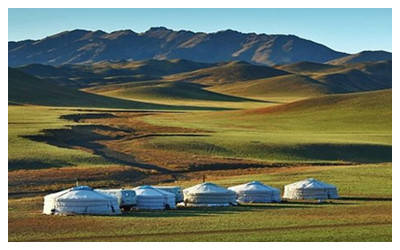- Home
- Province Guide > Inner Mongol >
Yurts of Mongolian
 The Ger, also called Yurt in Turkish, the characteristic domed round tent, which is the traditional dwelling of the Mongol. Many Mongols live in modern urban housing for a part of the year, but switch to the ger at other times of the year in order to tend to domestic animals (sheep, goats, etc.).
The Ger, also called Yurt in Turkish, the characteristic domed round tent, which is the traditional dwelling of the Mongol. Many Mongols live in modern urban housing for a part of the year, but switch to the ger at other times of the year in order to tend to domestic animals (sheep, goats, etc.).
Yurts are the places where generations of Mongolians live; they are traveling tents. As the Mongolians lead a nomadic life and live in places where there is water and grasses, they invented a convenient yurt that could be taken up or down.
Yurt has a history of more than a thousand years. It was called “Gonglu” or “Zhanzhang” in the past. It is a cylinder with a spike roof. The yurts are generally supported by struts made from willow and camel-hair strings, with 1 to 2 coats of white felts covering the tops and sides. There is a skylight in the middle of the yurt for daylighting and ventilation.
The Mongolian Yurt is practical in every way: it is quickly collapsible and packs away to almost nothing, making it easy to transport; its ground-hugging base and its conical top - which also sheds rain instantly - help keep the ger snug to the ground, even in strong winds; and inside, it is very roomy and ventilated.
The Mongolian Yurt consists of a wooden, lattice frame, sometimes in sections, which, on location, is erected into a circle and secured with strips of rope, forming a head-high, self-supporting cylinder over which an insulating layer of felt is stretched. The felt is fashioned from the wool of the sheep that the Mongol tends in large flocks, while the wood - entirely unavailable on the treeless steppe - must be purchased in the shops in the valleys below. A door frame and roof poles as well as a canvas outer covering complete the yurt. For additional stability, especially during particularly windy weather, a heavy weight is suspended from the center roof poles of the ger, i.e., inside the tent. The Yurt can be quickly disassembled and readied for transport - by yak or camel, the usual mode of transport on the steppe - to the next destination.
There are a number of cultural restrictions with regard to the Yurt that visitors should be aware of. For example, there are specific areas within the Yurt designated for men, for women, for cooking, and for worshipping. One must not approach a Yurt by automobile, horse, etc., within a certain radius, visitors must not touch the entrance-way, and inside the ger, visitors must not loiter in the kitchen area nor may they touch the center roof poles. Guests may first be seated when invited to do so by the hosts, and male and female guests sit separately, with males to the right and females to the left.
 The Ger, also called Yurt in Turkish, the characteristic domed round tent, which is the traditional dwelling of the Mongol. Many Mongols live in modern urban housing for a part of the year, but switch to the ger at other times of the year in order to tend to domestic animals (sheep, goats, etc.).
The Ger, also called Yurt in Turkish, the characteristic domed round tent, which is the traditional dwelling of the Mongol. Many Mongols live in modern urban housing for a part of the year, but switch to the ger at other times of the year in order to tend to domestic animals (sheep, goats, etc.). Ask Questions ?
Ask Questions ?